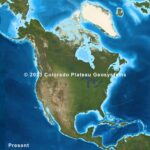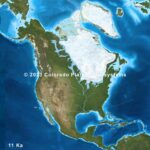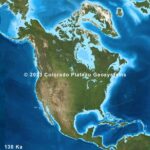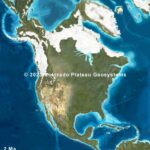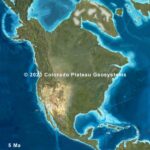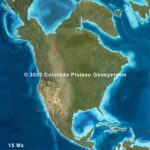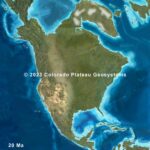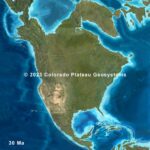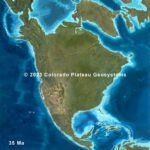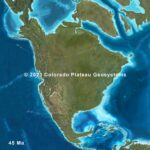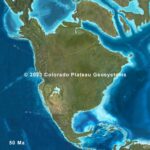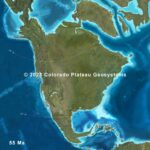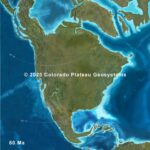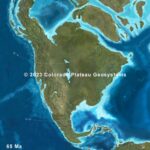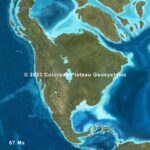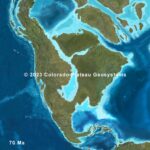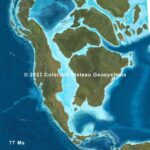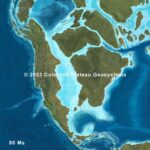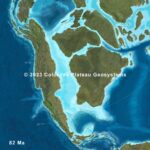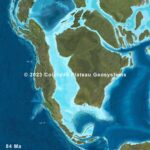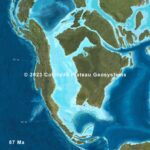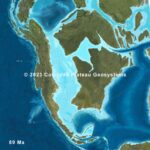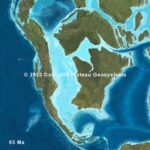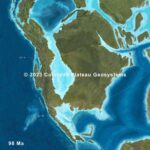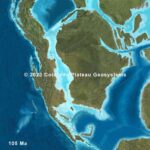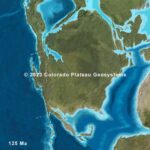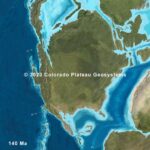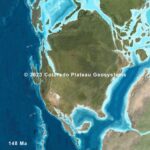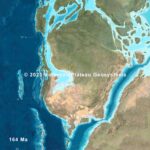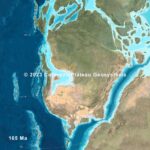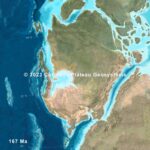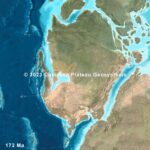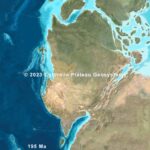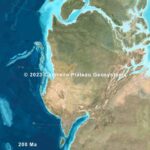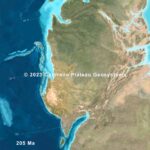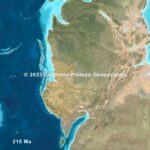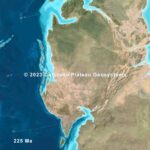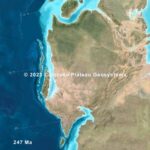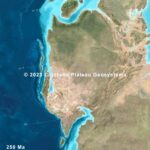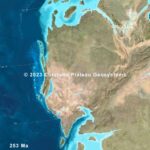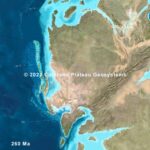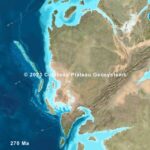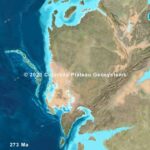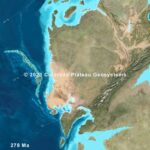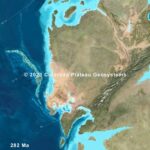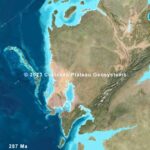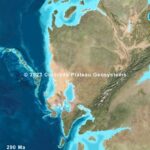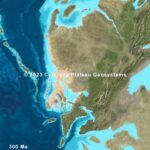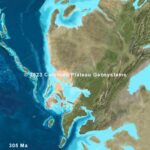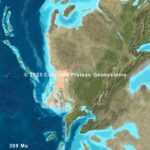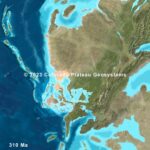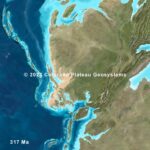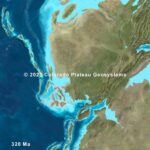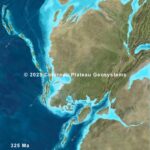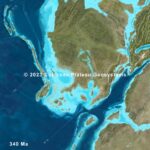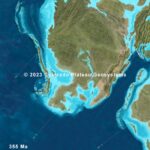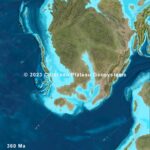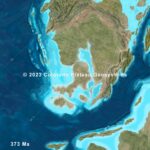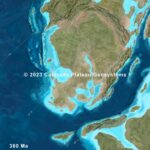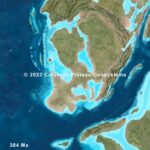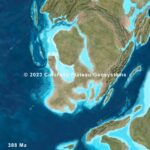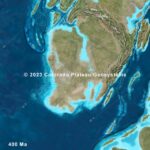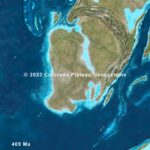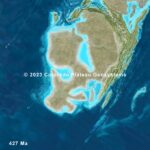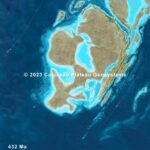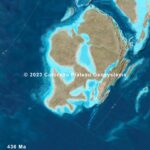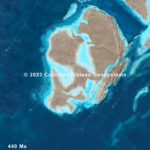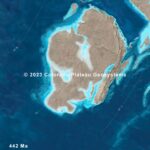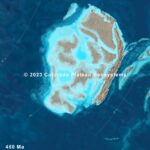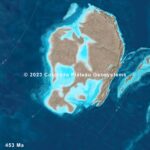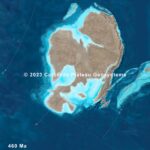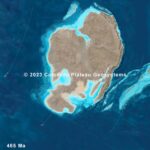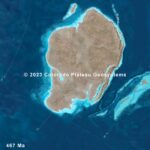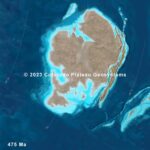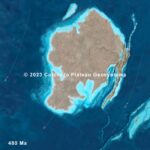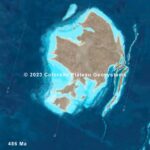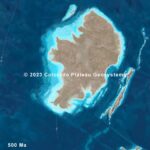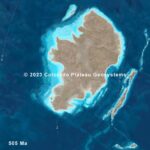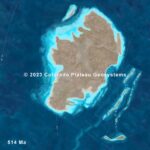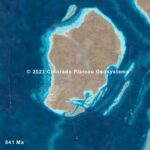North America
- Time Slices: 93
- Date Range: 541 Ma to Present
- Resolution: 14500 X 15018 pixels (~48 X 50 inches @ 300 dpi)
- File formats: JPG – most range from 60 – 80 megabyte
- Maps include coverage of the Arctic, Caribbean, Central America, parts of Western and Northern Europe, NW Africa, and Northern South America
State and Province boundaries are shown. Paleo latitude lines are also shown.
If any facies/tectonic maps for the time slice purchased are available they will be sent upon request.
List of references – the sources of data used in constructing the maps.
The previous Key-Time-slice series of paleogeographic maps for North America was completed in June, 2013; this new series replaces that one, is partly based on it, and is greatly expanded from it. The North America in Deep Time (© 2023) maps represent a significant revision of the previous North American series; map size and resolution were increased by 4 ½ times, more than twice as many map time slices, and new data from the geologic literature were used in map preparation. Their detail and image size make them some of my most detailed maps. The maps were compiled from many sources (see references) and are based on many different tectonic models; numerous compromises between varying models were necessary, especially models of terrane accretion. Particular attention was paid to making sure that tectonic and geologic events between adjacent time slices made geologic, geographic (space issues), and tectonic sense. The series was initiated in 2017 and took nearly 6 years to complete; most maps include 100 – 200 hours of work each, including reference work, map layout, and the various methods used in map construction. Like all our series, these are pixel-based and created in Adobe Photoshop ®. The time slices average 6 m. y. between maps (600,000,000 yrs/ 93 maps) but many maps are much closer together than this figure. Actual spacing is based on many factors.
All features on the maps are palinspastically restored — that is, the positions of various terranes and blocks are shown in their presumed location during a given time slice. Note that state lines are not deformed, a common method of showing palinspastic restorations in many publications; rather state-county lines are minimized until the time slice at which the terrane arrives at its present location for a given area, although some terranes have state boundaries on them as they approach North America. Terrane-block motion is shown (restored) relative to the interior stable craton of North America. By not deforming state lines, the paleogeography shows more clearly and without confusing lines.
Additional Notes
- Maps are rasterized pixel images, not shape files (nor are they based on shape files)
- Paleogeographic and paleotectonic elements (thrust belts, volcanic centers, paleo-shorelines, dune fields, basin geometry, facies maps, etc.) are plotted from the geologic literature and redrawn, repositioned, or reprojected on the base maps for the given time slices. This information is then used to construct the paleogeography
- Paleogeography is cloned or painted using Photoshop®; cloned images are mostly from GeoMapApp, a marine geoscience, global topography data system (http://www.geomapapp.org/)
- Cloned modern Earth DEM images from GeoMapApp are selected as modern analogues for the paleo-features they are chosen to represent; most DEM images have been re-colored, resized, and/or re-shaped in Photoshop®
- All map elements, both internal to North America and fringing or exotic, are palinspastically restored to each given time slice using recent data from literature
- Paleoclimate patterns, shown via hues of greens vs browns and tans, are generalized; pre-Siluro-Devonian(> 400 Ma) maps are uniformly drab, reflecting lack of significant continental vegetation
- Paleogeographic map time slices are tied to a given age based on stratigraphic/biostratigraphic correlation. This age is converted to time in millions of years (Ma) before present (thousands – Ka for Pleistocene) using the time scale of The International Chronostratigraphic Chart v. 2020/01 (www.stratigraphy.org). The age given to the time slice is based on the principle of correlating fossil data to the chronostratigraphy (estimated numerical age based on radiometric methods). The accuracy of this varies based on fossil content present in rocks of a given age and extrapolated for times of poor fossil control or when correlation is uncertain. Not all tectonic and stratigraphic features shown on a given map can be correlated to a given instant or short range of time and most maps probably range from +/- 1 or 2 million years deviation from the time shown for the map.
- Time terms used in the map titles can be confusing. The use of these terms is as follows: System/Period (Cambrian, Ordovician, … Quaternary), Series/Epoch (mostly Lower, Middle, and Upper), and Stage/Age (subdivisions of Series/Epoch) follow the International Chart (time scale) listed above; however, because of their wide usage in North America, North American Stage/Age terms (Kinderhookian, … Ochoan) are used for Mississippian, Pennsylvanian, and Permian map titles.
- North America is a large continent and because of this and the fact that the Earth’s surface is spherical, any map projection has errors in distance or direction from point to point, or both. On these maps, distortion is greatest at the corners of the map and improves towards the center.
- The Equator and other latitudinal lines shown for a given time are approximate; as such, they should be used for general location of latitude and not for plotting specific locations. Paleozoic lines are modified from Torsvik et. al (2012) and Mesozoic lines are modified from Seton et. al (2012).
Paleogeography of North America – Map Projection Data
Map projection and political boundaries from:
Garrity, C. P., and Soller, D. R., 2009, Database of the map by J. C. Reed, Jr. and others (2005): US Geological Survey data series 424 (DVD)
- Map_Projection_Name: Transverse Mercator
- Scale_Factor_at_Central_Meridian: 0.926000
- Longitude_of_Central_Meridian: -100.000000 (100°W longitude)
- Latitude_of_Projection_Origin: 0.000000 (Equator)
NORTH AMERICA IN DEEP TIME:
INDEX OF MAPS
MAP Series / Epoch
QUATERNARY MAPS
00 Present
11 Ka Pleist-Holo
21 Ka Pleistocene-Wisc
130 Ka Pleist-Sang
2Ma Pleistocene
NEOGENE MAPS
5 Ma Pliocene-Miocene
10 Ma Miocene
15 Ma Miocene
20Ma Miocene
PALEOGENE MAPS
30 Ma Oligocene
35 Ma Eocene
45 Ma Eocene
50 Ma Eocene
55 Ma Eocene
60 Ma Paleocene
65 Ma Paleocene
CRETACEOUS MAPS
67 Ma Late (Upper)
70 Ma Late (Upper)
77 Ma Late (Upper)
80 Ma Late (Upper)
82 Ma Late (Upper)
84 Ma Late (Upper)
87 Ma Late (Upper)
89 Ma Late (Upper)
93 Ma Late (Upper)
98 Ma Late (Upper)
105 Ma Early (Lower)
120 Ma Early (Lower)
125 Ma Early (Lower)
140 Ma Early (Lower)
JURASSIC MAPS
148 Ma Late (Upper)
154 Ma Late (Upper)
164 Ma Middle
165 Ma Middle
167 Ma Middle
170 Ma Middle
172 Ma Middle
180 Ma Early (Lower)
185 Ma Early (Lower)
195 Ma Early (Lower)
200 Ma Early (Lower)
TRIASSIC MAPS
205 Ma Late (Upper)
210 Ma Late (Upper)
215 Ma Late (Upper)
225 Ma Late (Upper)
240 Ma Middle
247 Ma Early (Lower)
249 Ma Early (Lower)
250 Ma Early Trisaaic?
PERMIAN MAPS
253 Ma Late (Upper)
260 Ma Middle
270 Ma Middle
273 Ma Early (Lower)
278 Ma Early (Lower)
282 Ma Early (Lower)
287 Ma Early (Lower)
290 Ma Early (Lower)
CARBONIFEROUS –PENNSYLVANIAN MAPS
300 Ma Late (Upper)
305 Ma Late (Upper)
309 Ma Middle
310 Ma Middle
317 Ma Early (Lower)
320 Ma Early (Lower)
CARBONIFEROUS — MISSISSIPPIAN MAPS
325 Ma Late (Upper)
340 Middle
350 Osage
355 Ma Early (Lower)
DEVONIAN MAPs
360 Ma Late (Upper)
373 Ma Late (Upper)
380 Ma Late (Upper)
384 Ma Middle
388 Ma Middle
400 Ma Early (Lower)
409 Ma Early (Lower)
SILURIAN MAPS
422 Ma Late (Upper)
427 Ma Middle
432 Ma Middle
436 Ma Early (Lower)
440 Ma Early (Lower)
442 Ma Early (Lower)
ORDOVICIAN MAPS
445 Ma Late (Upper)
450 Ma Late (Upper)
453 Ma Late (Upper)
460 Ma Middle
465 Ma Middle
467 Ma Early (Lower)
475 Ma Early (Lower)
480 Ma Early (Lower)
CAMBRIAN MAPS
486 Ma Late (Upper)
500 Ma Middle
505 Ma Middle
514 Ma Early (Lower)
541 Ma Early (Lower)
8/7/23
Quarternary-Neogene Maps
Paleogene Maps
Cretaceous Maps
Jurassic Maps
Triassic Maps
Permian Maps
Pennsylvanian Maps
Missippian Maps
Devonian Maps
Silurian Maps
Ordovician Maps
Cambrian Maps

